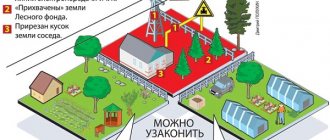How to legalize a land plot?
There is one caveat: if registration occurs en masse, i.e. Most members of the cooperative want to do this, having powers of attorney from people in their hands; the chairman of the cooperative can do this. The chairman, having been forced to bypass numerous authorities more than once, may be more experienced in communicating with officials and know the pitfalls of the bureaucratic machine. But many people prefer to solve this issue on their own. In the case of cooperatives, there is no need to obtain permission from the administration to register property.
Registration procedure
The privatization process involves a preparatory stage, collection of relevant documentation and registration of rights to the site. The likelihood of a successful outcome of the case is reduced to zero if the second participant in the conflict makes efforts to defend his property. Otherwise, you can hope to obtain ownership rights.
ATTENTION! The likelihood of success increases if illegal buildings have not been erected on the land.
Preparation
Before submitting documents to the registration authority, you must:
- Establish the official owner of the allotment . If it cannot be found, it is necessary to register the land with the cadastral register. In this case, the privatization procedure can begin only after a year by purchasing the plot from the local authorities.
- Carry out land surveying if it has not been done previously. Despite the fairly high cost of the procedure, it is necessary because the cadastral plan is included in the list of documents required to register ownership.
Read more: What payments are due upon dismissal due to redundancy?
The preparatory stage is necessary to establish the value of the site for further purchase and legal exploitation.
List of documents
To obtain a cadastral passport you will need:
- applicant's personal passport;
- title documents for the site;
- land surveying and geodesy plans;
- relevant petition;
- receipt of payment of state duty.
After the required document has been issued, you must submit to the registration authority:
- a corresponding petition (a sample can be found from employees);
- cadastral passport;
- the applicant's identity card (personal passport);
- a document confirming the option of obtaining land;
- check for payment of state duty;
- land title document obtained from the administration;
- information about the non-use or exploitation of the site before seizure, indicating the timing;
- decision of the visiting commission.
Where to contact
The circulation authority depends on the stage of registration of land rights.
- If a cadastral plan is required, you must contact the BTI and pay for the services of the appropriate specialist.
- To obtain ownership rights, you need to visit the land department of the local administration and submit an application.
- To register your rights to an allotment, you can contact Rosreestr or the territorial branch of the MFC with a list of necessary documents.
ATTENTION! Before contacting the registration authority, you must pay a fine in the prescribed amount for illegal exploitation of land and attach a confirming receipt.
It should be taken into account that obtaining rights to unauthorized occupied land is only possible if:
- the entire necessary list of documents is submitted, each of which complies with legal requirements;
- there is no legal proceedings to determine the boundaries of this site; there is a land surveying plan;
- there is no conflict with a third party claiming their rights to the allotment.
REFERENCE! The municipality's refusal to register land rights can only be appealed in court.
Deadlines
The period for obtaining land rights consists of the following periods:
- obtaining an extract from Rosreestr about the cadastral number of the plot (7 days);
- extract of title (2 weeks);
- drawing boundaries and obtaining a new cadastral number in case of its absence (14 days);
- the arrival of the visiting commission and receipt of its decision (this may take up to several months);
- Registration of property rights after submitting documents is carried out within 21 days.
Price
The amount of financial costs for obtaining land rights is not fixed and consists of the following factors:
- state duty (2 thousand rubles for individuals and 22 thousand rubles for legal entities);
- payment for the services of a cadastral engineer (depending on the region);
- payment of penalties.
Read more: How bailiffs sell seized property
It turns out that the price of privatization of squatting is from 2,000 to several tens of thousands of rubles.
Is it possible and how to legalize unauthorized construction on a site?
The only condition is that the buildings comply with quality standards accepted in the construction industry. Self-construction is considered to be any type of real estate (house, bathhouse, warehouse, barn) that is built on a land plot not intended for use for such purposes or buildings that were built without obtaining construction permits. Buildings that do not comply with building codes and urban planning rules are also recognized as unauthorized construction. Unauthorized construction excludes the following actions: obtaining property rights; the ability to dispose of real estate; possibility of making transactions. Civil law specifies that a self-construction must be demolished if ownership rights to it are not legally recognized.
We recommend reading: Law on the burial of war veterans
Built a house on the site: how to legalize it
- Documents establishing the right of ownership of the land on which the illegal building was erected;
- Documentation confirming the fact of construction of the building, as well as reflecting the costs incurred by the owner of the site for the construction of an illegal structure;
- A technical passport issued by the BTI as confirmation of the existence of an unauthorized building;
- An extract containing information that the unauthorized construction is not the property of citizens other than the applicant . It also states that it is not claimed by third parties and there are no restrictions on the approval of ownership of the structure. Requested in the unified state register of rights to real estate and transactions with it;
- Conclusion of a special technical commission on the actual condition of the building and its environmental status. The same conclusions must be obtained from the sanitary and epidemiological station and the fire service.
- Statement;
- Documents establishing land ownership;
- Urban planning documentation with a site plan;
- Construction permit;
- Official act of acceptance of the building;
- Documentation confirming that the overhaul facility complies with all technical requirements of construction regulations, signed by the person who carried out the construction of the building;
- Documentation confirming that the overhaul facility meets all technical requirements, signed by employees of the services operating the engineering structures of the building;
- A plan diagram showing the location of the completed capital construction facility, various engineering networks and wiring on the site, as well as a diagram of the site itself.
We recommend reading: Documents Required to Obtain a Tax Deduction on a Mortgage
How to legalize a land plot without documents or its squatting
very relevant. The complex procedure for processing and collecting documents confuses people. This is a long and complex process, and the list of required documents depends on what documents the owner initially has. The list of documents required for legalization of a land plot and subsequent registration can be found at the territorial real estate registration office. Along with the application of the owner or his representative, the following documents are provided: a passport or constituent documents of the enterprise, a notarized power of attorney, if this is an attorney, a boundary plan of the site, a cadastral passport, documents on the basis of which the site was acquired into ownership - purchase and sale, donation agreements , document on inheritance, etc.), a decision of the municipal authorities on the allocation of land, an act of transfer of land into ownership, a check for payment of the state duty, and a document on the value of the object, which is issued by the Land Cadastral Chamber. The territorial department of state registration is given 20 calendar days to carry out the necessary examinations and enter new data into the unified register of rights. Thus, by submitting the decision to Rosreestr, the owner receives a certificate that records his rights to this plot. The entire process of legalizing a land plot can take several months. How to legalize self-occupation of a land plot Self-occupation of land occurs when there are no legal grounds to erect a construction project.
We recommend reading: Is it possible to re-file for divorce?
Responsibility for squatting
Government institutions monitor compliance with the norms of the Land Code of the Russian Federation. If illegal use of the territory is detected, an act of offense is drawn up, and on the basis of the document the citizen is held accountable.
Unauthorized seizure of a site is considered an administrative violation (Article 7.1 of the Code of Administrative Offenses of the Russian Federation). The fine is:
- for individuals – from 1 to 5% of the cadastral value of land;
- for legal entities – from 2 to 3%;
- for officials – from 1.5 to 2%.
If the value of the territory is not indicated, the fine for damage to the state is assigned in a fixed amount and ranges from 5,000 to 200,000 thousand rubles.
The privatization of land often becomes a subject of dispute, especially regarding the appropriation of a plot without legal grounds. In the latter case, we are talking about self-capture - a fairly popular method of obtaining an allotment. It allows you to become the owner of a new plot or expand an existing one without the permission of the municipality. But in order for this procedure to take place without consequences, you should know how to formalize the squatting of land into ownership and what the risks are.
Unauthorized land can be partially registered as property
“Seized” acres will now be allowed to be registered as property. Unless, of course, your neighbor doesn't mind. Photo: seedviva / istock
Russians will have this right on September 16, when amendments to the laws on cadastral activities and on state registration of real estate come into force. Often, summer residents or village residents use not only the land that they once bought or received for use, but also the neighbor’s “no man’s land.” As Parviz Tukhtasunov, director of the Federal Cadastral Chamber of Rosreestr, clarified to RG, the amendments make it possible to legitimize the acres used for many years, but subject to certain conditions.
It is imperative to use the “seized” acres for more than 15 years, not to have disputes with neighbors, as well as claims from authorities. If a municipality orders complex cadastral work and cadastral engineers identify unauthorized plots, they reflect this information in their reports. The decision to adjust the borders is made by Rosreestr.
At the same time, it will not be possible to register all unauthorized occupied acres as property. According to the law, the area of the “cut” territory must not exceed the maximum minimum size of the land plot established by the regional administration. Or, if a limit is not established, no more than 10 percent of the area of the main - legally acquired plot.
It also becomes possible to carry out complex cadastral work without an approved land surveying project, if in accordance with the Town Planning Code the development and approval of such a project is not required. Thus, eliminating the need to spend money from the budget on preparing a land surveying project, amendments to the legislation facilitate the implementation of complex cadastral work. They are carried out by order of state authorities (in Moscow, St. Petersburg, Sevastopol) or local government (in other regions of the country, municipal districts, urban districts) at the expense of the budget.
The specifics of carrying out complex cadastral work for land plots occupied by public objects (territories) located within the boundaries of horticultural, vegetable and forest plots are also determined. Interestingly, it will now be possible to employ a cadastral engineer on staff, but only if the company needs to carry out cadastral work for its own needs.




